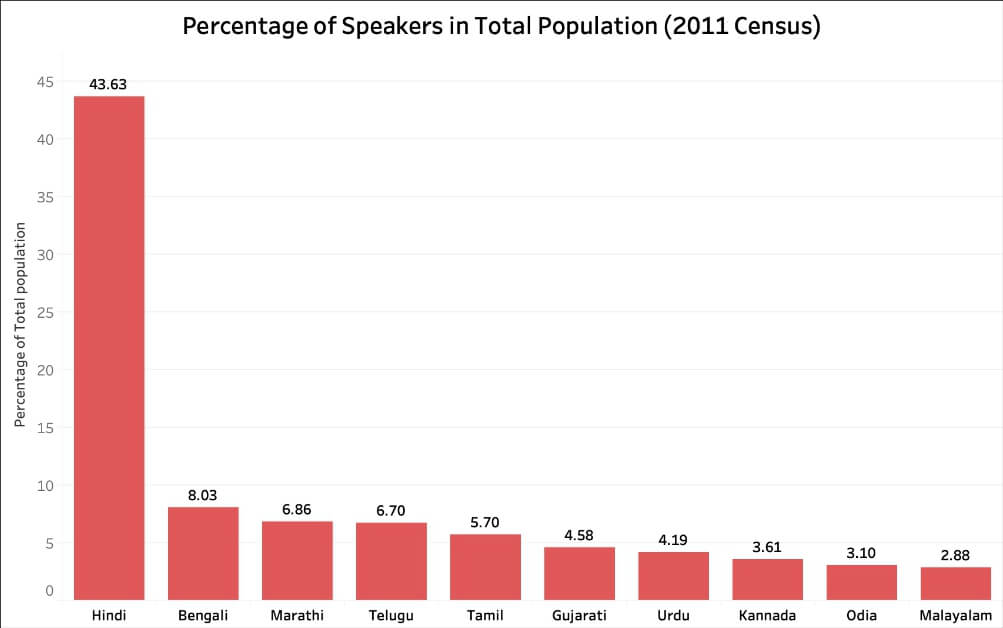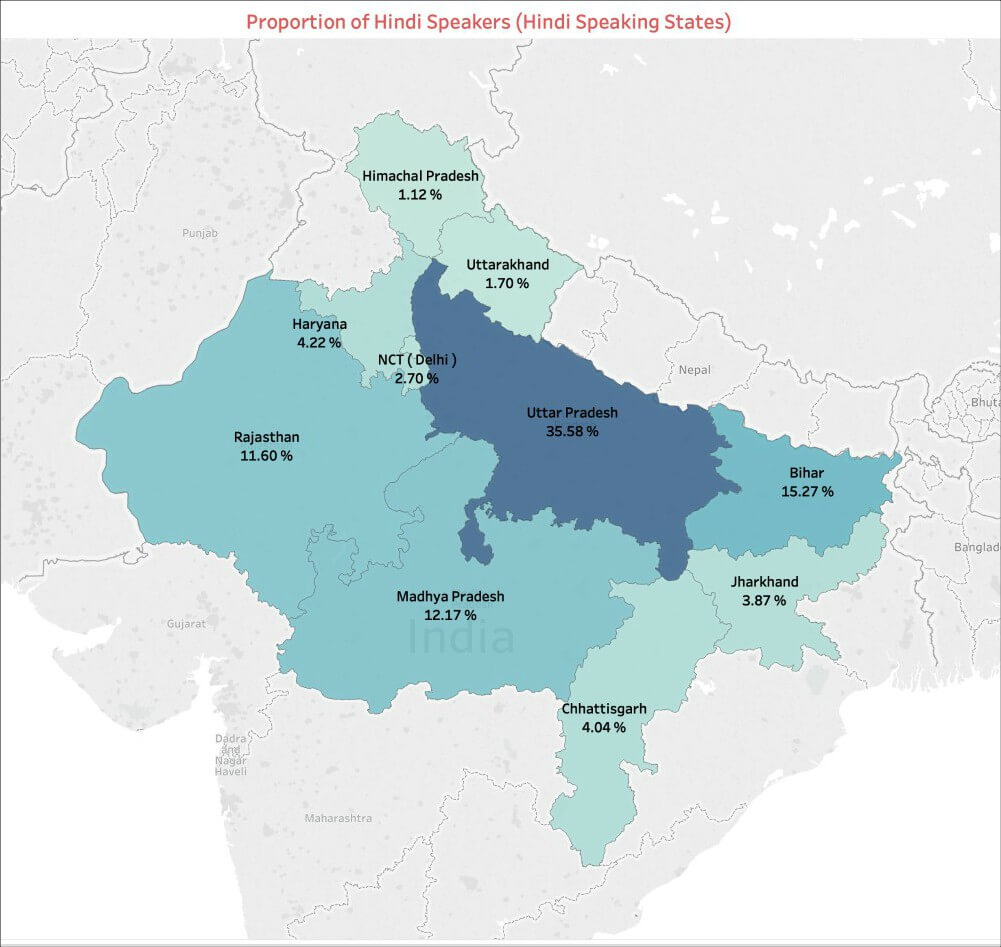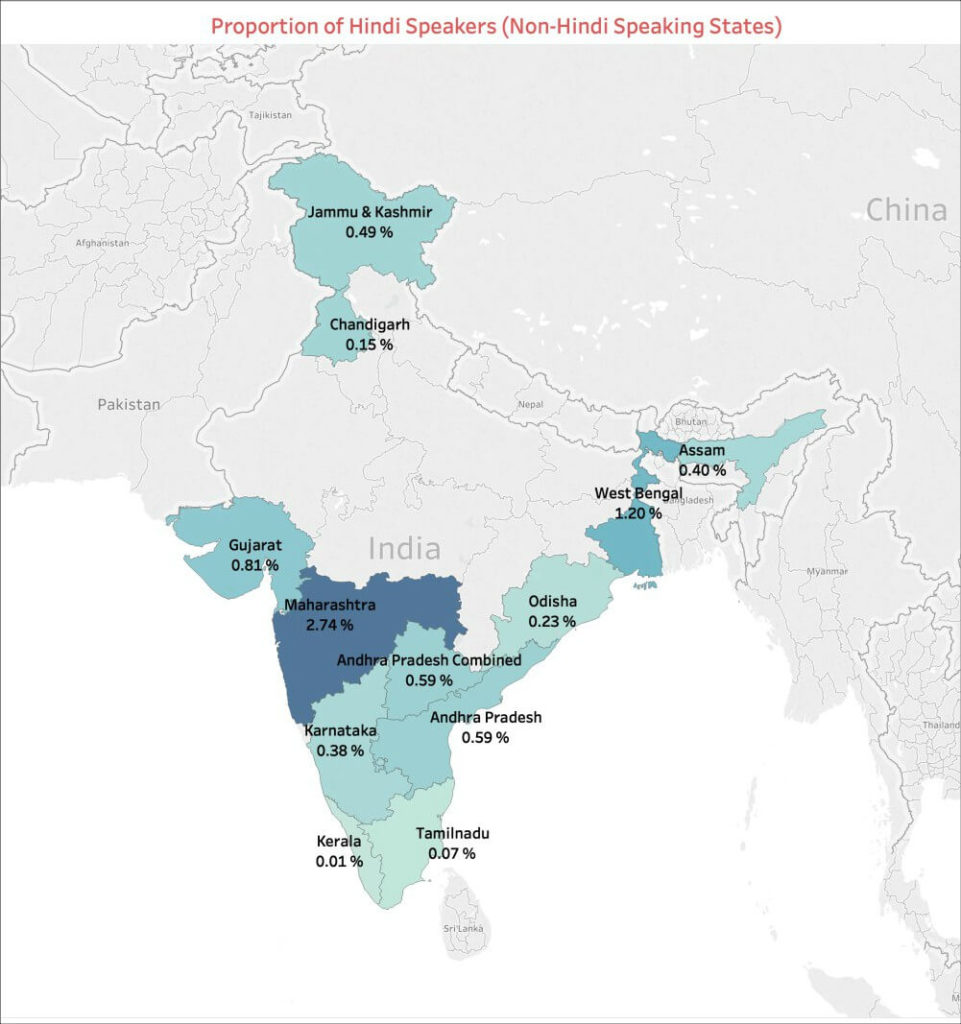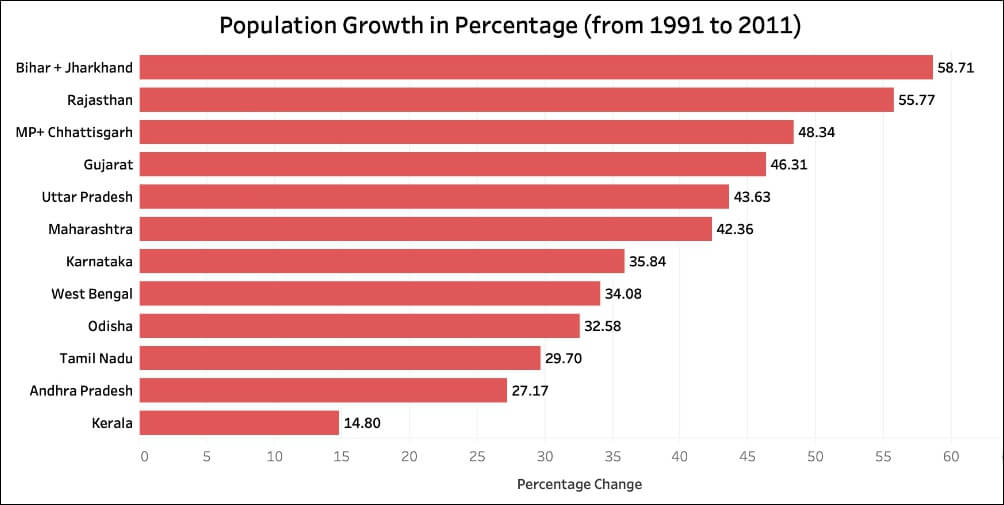[orc]Has population growth something to do with the language debate? We look at the numbers.
Is language a means of communication or an identity of one’s culture?
A reflection of this conundrum provides insights into the reasons behind the invigorated debate around Hindi imposition and the resistance, which was brought back into limelight thanks to the recent draft National Education Policy (2019) submitted by Kasturirangan committee.
Irrespective of the controversy around the alleged imposition of Hindi, the numbers relating to speakers of various language, do tell a story – the story of Hindi’s growth over the decades.
Hindi – the larger chunk
As per the 2011 census, Hindi constitutes the largest share of speakers in India.
The below table illustrates the number of speakers and their percentage of population, of the 10 largest spoken languages in India. It has to be noted that the number of speakers is calculated from those who returned a particular language as their mother tongue during the census exercise.
| S. No. | Language | No.of Speakers | Percentage of Total population |
| 1 | Hindi | 52,83,47,193 | 43.63 |
| 2 | Bengali | 9,72,37,669 | 8.03 |
| 3 | Marathi | 8,30,26,680 | 6.86 |
| 4 | Telugu | 8,11,27,740 | 6.70 |
| 5 | Tamil | 6,90,26,881 | 5.70 |
| 6 | Gujarati | 5,54,92,554 | 4.58 |
| 7 | Urdu | 5,07,72,631 | 4.19 |
| 8 | Kannada | 4,37,06,512 | 3.61 |
| 9 | Odia | 3,75,21,324 | 3.10 |
| 10 | Malayalam | 3,48,38,819 | 2.88 |

The numbers ascribed to these languages includes the various dialects spoken. For ex: Hindi includes – Bundeli, Haryanvi, Bhageli, Braj, Khari-boli, Avadhi etc. Similarly, Bengali has – Rajbhanshi, Manbhumi, Sundarbani, Rarhi etc.
The ever-increasing share in the pie
Hindi has always been the largest spoken language in Independent India. However, the significant aspect which needs to be noted from the 2011 census data, is that it is growing at a much higher and positive rate when compared to the other major languages in India.
The numbers clearly indicate to consistent increasing trend in the number of Hindi speakers in India.
Let’s take a look at the proportion of the population who speak the top 10 languages have over the last four decades, from 1971 to 2011.
| Percentage of population | Change over 40 years | ||||||
|---|---|---|---|---|---|---|---|
| Census Year | 1971 | 1981 | 1991 | 2001 | 2011 | Net Change | % Change |
| Hindi | 36.99 | 38.74 | 39.29 | 41.03 | 43.63 | 6.64 | 17.95 |
| Bengali | 8.17 | 7.71 | 8.30 | 8.11 | 8.03 | -0.14 | -1.71 |
| Marathi | 7.62 | 7.43 | 7.45 | 6.99 | 6.86 | -0.76 | -9.97 |
| Telugu | 8.16 | 7.61 | 7.87 | 7.19 | 6.70 | -1.46 | -17.89 |
| Tamil | 6.88 | ** | 6.32 | 5.91 | 5.70 | -1.18 | -17.15 |
| Gujarati | 4.72 | 4.97 | 4.85 | 4.48 | 4.58 | -0.14 | -2.97 |
| Urdu | 5.22 | 5.25 | 5.18 | 5.01 | 4.19 | -1.03 | -19.73 |
| Kannada | 3.96 | 3.86 | 3.91 | 3.69 | 3.61 | -0.35 | -8.84 |
| Odia | 3.62 | 3.46 | 3.35 | 3.21 | 3.10 | -0.52 | -14.36 |
| Malayalam | 4.00 | 3.86 | 3.62 | 3.21 | 2.88 | -1.12 | -28.00 |
The following trends emerge from these numbers.
- The percentage of Hindi speakers has gone up by 6.64 points (36.99% to 43.63%), a whopping increase of 17.95%, in four decades.
- All the other top 10 spoken languages have recorded a declining share in the proportion of the population speaking that language.
- The proportion of speakers of the South Indian languages Telugu, Tamil, Kannada and Malayalam has gone down by 17.89 %, 17.15 %, 8.84 % and 28% respectively.
- Marathi and Oriya have also seen a significant drop with 9.97 % and 14.36 %
- Urdu, which is another language not specific to a state has also seen a significant drop by 19.73 %
It is evident from the numbers that Hindi is the only major language whose proportion of speakers is increasing at an India level. But, where does the Hindi language get its numbers from?
Hindi Heartland – The major contributor
Apart from being the official language used for communication at the center along with English, Hindi also happens to be the official language of 10 states – Uttar Pradesh, Bihar, Rajasthan, Madhya Pradesh, Chhattisgarh, Jharkhand, Uttarakhand, Haryana & Himachal Pradesh along with National Capital Territory (Delhi).
While there are other languages which are spoken in these states, Hindi is the predominant language. The numbers which are added up to Hindi includes all the dialects that are spoken in these states. Each of the dialects are distinct from each other.
The 2011 Census provides details of the total number of speakers of a particular scheduled language, in each of the states.
Below is the representation of the share of each of the Hindi speaking state of the total number of Hindi speakers in India.

The following emerges from the data.
- 92.28 % of Hindi speakers in the country come from the 10 major Hindi speaking states.
- Uttar Pradesh contributes to more than 1/3rd of the Hindi speakers in the country
- Bihar, Madhya Pradesh and Rajasthan combine to contribute to another 2/5th of the Hindi speakers in India.
These numbers are completely different when we look at the non-Hindi speaking states.

As the data indicates:
- Top ten non-Hindi speaking states & UTs contribute 7.49 % of the Hindi speakers.
- Maharashtra, West Bengal & Gujarat having significant Hindi speaking populations at par with few of the Hindi-speaking states.
Further, the proportion of Hindi speakers within the states is less for the southern states. In AP and Karnataka only 3.69 % and 3.6 % of the state population are Hindi speakers. Tamil Nadu and Kerala have lesser proportion with only 0.55% and 0.16% of population being Hindi speakers.
Population explosion, the major contributor for increase in Hindi speakers
From the data presented above, it emerges that
- The percentage of Hindi speakers has predominantly increased over the years.
- The proportion of speakers of other major languages has come down.
This disproportionate increase is due to the increased contribution from the Hindi speaking states and the lower growth rates of the non-Hindi speaking states. The analysis is incomplete, unless the dimension of ‘Population Growth’ is also considered.
Let us look at the population growth in few of the state with high population. The data from 2011 census is compared with the data of 1991 Census. The following chart shows the population growth rate in 20 years (from 1991 to 2011) in major states.

Two major trends that can be observed from this comparison are:
- Population has grown exponentially in the key Hindi speaking states along with Maharashtra and Gujarat which also have sizeable Hindi speaking population. (Marathi and Gujarati also happen to be the two languages with minimal dip in proportion of native speakers)
- The Southern states have comparatively lower percentage of population growth over the last two decades. This in turn reflects in the major dip in the proportion of speakers of respective native languages (Telugu, Tamil, Kannada & Malayalam).
What does all this mean for the language debate?
Certain studies show the direct relationship between socio-economic factors and population growth in India. The southern states which do well on socio-economic factors have comparatively less population growth, compared to the northern states (especially, the states in the Hindi Heartland) that have not controlled population growth.
Hindi has benefitted from this population growth and this phenomenon has given way to new narratives.
- Is the good performance of southern states on socio-economic factors and on population growth control front, resulting in loss of respective native language speakers?
- What kind of impact will the current population growth trends would have on representation of the states in the legislative bodies in the future?
- Standardization of a language influencing the dialects and they losing out in the longer run.
There is a section of people who have an alternative view point of using Hindi as an “Umbrella” language for a host of various dialects and imposing standardization.
The data does point out the major increase in the number of Hindi speakers, being largely a result of standardization beyond the dialects and an exponential population growth. While, there are arguments in favour of promoting Hindi, there are many other questions that need to be considered before an answer is arrived at.
Rather than making the issue as ‘for or against’- Hindi, many aspects like preserving the form and nature of various dialects, the aspirations of southern states and other non-Hindi speaking regions, socio-cultural context etc. needs to be considered and reviewed in any discourse relating to the concept of ‘National Language’.
Featured Image: Indian Languages


